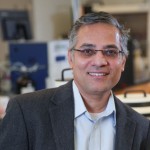
Dr. James S. Chickos
James S Chickos was born in Buffalo, NY, of Greek parents. He received his BS in chemistry at the University of Buffalo, now SUNY–Buffalo, and his Ph D in organic chemistry from Cornell University with Donald G Farnum. After postdoctoral fellowships, first at Princeton with Kurt Mislow and then at Wisconsin–Madison with Bob West he joined the faculty at UM–St Louis where he is now Professor of Chemistry. He was trained as a physical organic chemist and essentially all of his research has been in the area, or close to it. His complete research record is certainly outstanding. He has about 115 publications including refereed articles, invited articles, a textbook and a web-based text. He has lectured extensively abroad and collaborates or has collaborated with many scientists from over a dozen different countries.
During his first few years at UM–St Louis, his research was in the area of unsaturated cyclic ketones, an interest from his graduate and postdoctoral work. Much of his early work was published in JACS as either single-author papers or as collaborations with UM–St Louis colleagues. His work on small ring compounds continued in the 1970s along with his interest in chiral compounds where the chirality derives from the presence of deuterium.
Over the last 22 or so years, Jim’s laboratory has established an international reputation in thermochemistry, leading to many collaborations and publications with scientists in France, Portugal, Russia, England, Spain, Israel, Japan, Italy, Germany, Switzerland, Romania, China, Mexico as well as the USA. He and his students’ and collaborators’ efforts in this area have been directed toward developing new, simpler instrumental methods for making thermochemical measurements and applying these techniques to specific compounds. Jim has coupled this effort with a systematic attempt to compile and critically evaluate thermochemical data in the area of organic transport properties. He and his students in the UM–St Louis Chemical Literature class have compiled a valuable collection of thermochemical information that is maintained by the National Institute for Standards and Technology (NIST). It is available free on line at webbook.nist.gov/chemistry/.
These extensive databases have provided Jim and his students a framework on which to develop mathematical estimation algorithms. The synergistic relationship between the database information and the estimation techniques has had and continues to have an impact in widely divergent areas such as in air and water pollution, pharmaceuticals, protein and even polymer chemistry. The work is of interest and value to chemists, chemical engineers, crystallographers, and physicists who need information on transport properties of the condensed phase. A colleague pointed out that what Jim has done is to make what appears to be a rather dull subject very interesting by his imaginative and innovative approach.
Jim has three children and lives close to the UM–St Louis Campus. He enjoys cycling, playing racquetball and keeping fit when he is not in the office or laboratory.


